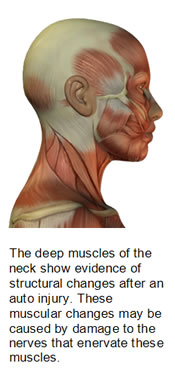Objective Evidence of Nerve and Muscle Changes after Whiplash Injury
One of the problems with whiplash diagnosis for many years was the lack of objective evidence of injury. Recent studies, however, have given us new tools that we can use to pinpoint organic lesions in many patients.
 Now, two new studies show that neck muscles show objective, anatomical changes after whiplash injury.
Now, two new studies show that neck muscles show objective, anatomical changes after whiplash injury.
The first study1 set out to see if there were detectable changes in the neck muscles of whiplash patients. Previous studies have shown that patients with spinal pain also show fatty infiltration of the muscles on MRI. The authors of this study studied 79 female whiplash patients and 34 healthy control subjects, all between the ages of 18-45. Each subject had a neck MRI focused on the cervical spine muscles.
The authors found:
- Whiplash patients had significantly larger cross section of the deep multifidus muscles at the C3-C7 spinal levels.
- Other spinal muscles in the whiplash patients showed an increase in size as well.
- There was no correlation between fatty infiltration and BMI or age.
- Symptom duration or severity did not seem to affect the degree of muscle changes.
The authors write that these, "alterations in the deep muscles may provide valuable insight into the common functional impairments observed in patients with persistent [whiplash."
Because these deep muscles play a critical role in postural control and balance, disruption of these muscles may result in other symptoms of whiplash, such as dizziness or vertigo.
The changes in muscle were found to occur as quickly as three months after injury.
Whiplash Different from Other Neck Pain
The same group of researchers decided to perform another study2 that compared the difference between whiplash patients and people with "chronic, insidious-onset neck pain." Their theory was that if disuse of the neck muscles was responsible for the fatty deposits in the muscle, it should be found in patients with non-traumatic neck pain as well as whiplash patients.
The study examined 23 women with chronic neck pain. Each subject was imaged with MRI, and was tested with pressure and thermal pain threshold tests.
The authors of the second study found that, "the results of this study provide preliminary data that female patients (18-45 years) suffering from persistent insidious-onset neck pain do not show quantifiable MRI changes in the fat content of the cervical extensor musculature and that their levels of fat mirror those with no history of neck pain. In addition to a lack of muscle changes, participants with insidious-onset neck pain did not demonstrate widespread sensitivity to sensory stimuli and the presence of these features is consistent with abnormal central pain-processing mechanisms; such as seen in some subjects with acute and chronic WAD."
These studies provide important insight into the problem of whiplash:
- Motor vehicle collision patients show objective evidence of muscle changes on MRI.
- Whiplash injuries are different from non-traumatic neck pain.
- Because fatty infiltration occurs only in whiplash patients, the cause of this phenomenon may be damage to the nerves of the spine.
- Elliott J, Jull G, Noteboom JT, Galloway G. MRI study of the cross-sectional area for the cervical extensor musculature in patients with persistent whiplash associated disorder (WAD). Manual Therapy 2008;13:258-265.
- Elliot J, Sterling M, Noteboom JT, Darnell R, et al. Fatty infiltrate in the cervical extensor muscles is not a feature of chronic, insidious-onset neck pain. Clinical Radiology 2008;63(6):681-687.
